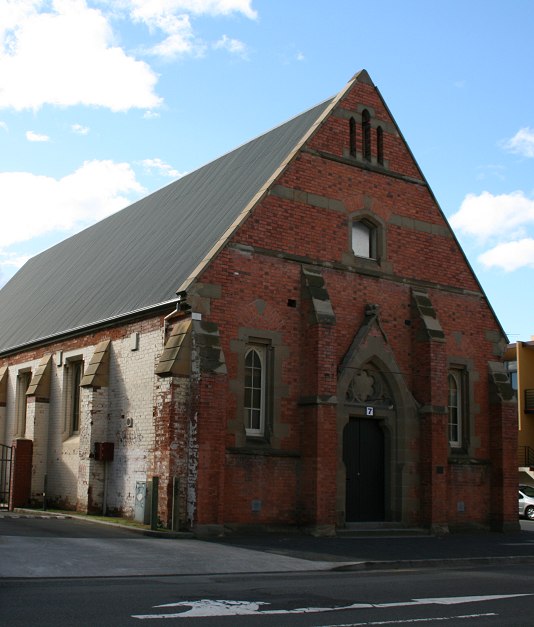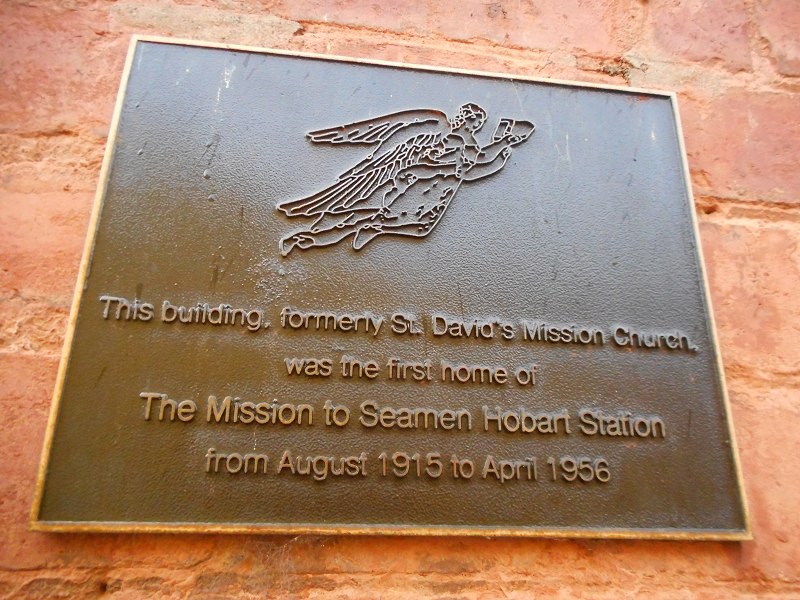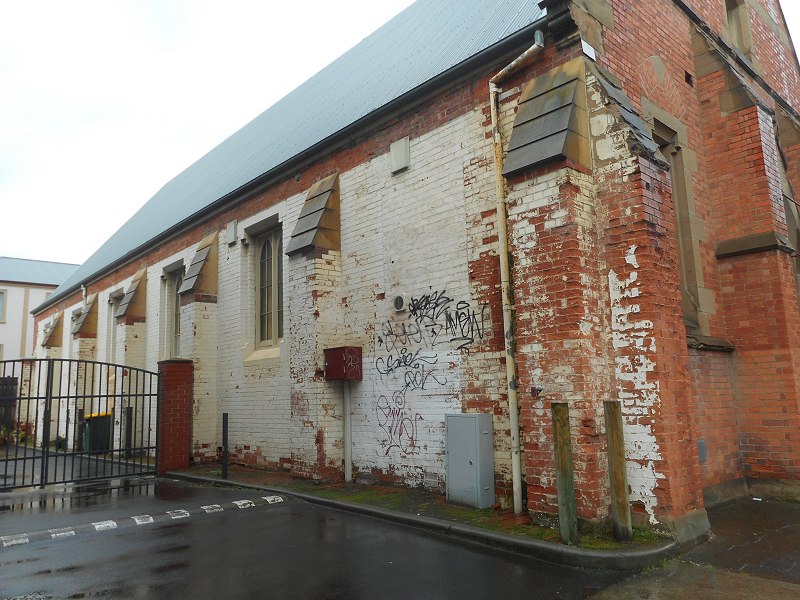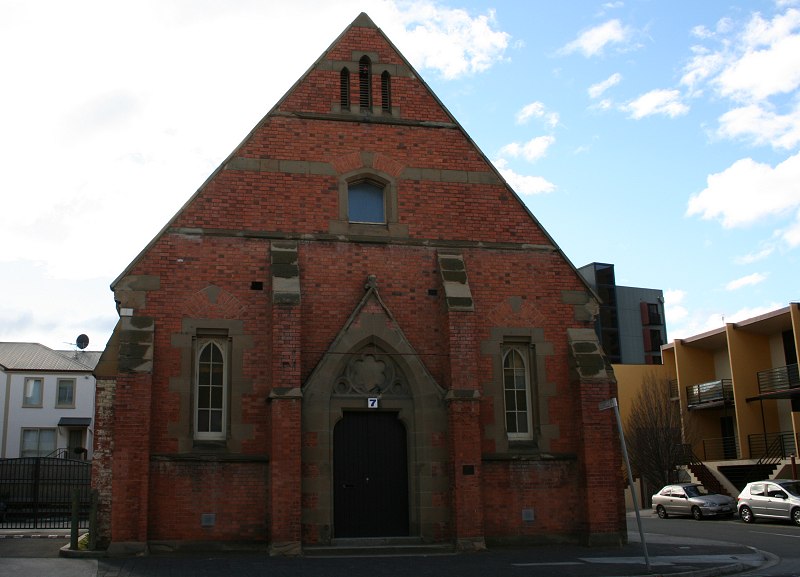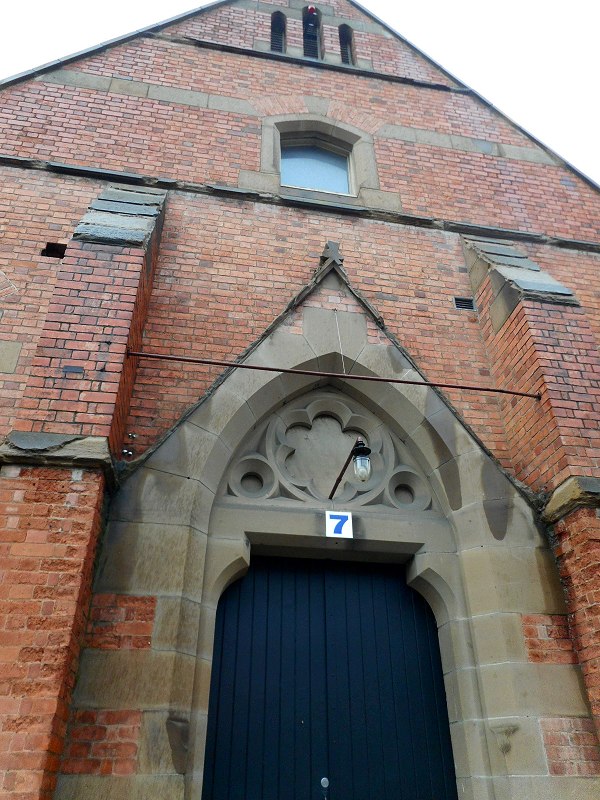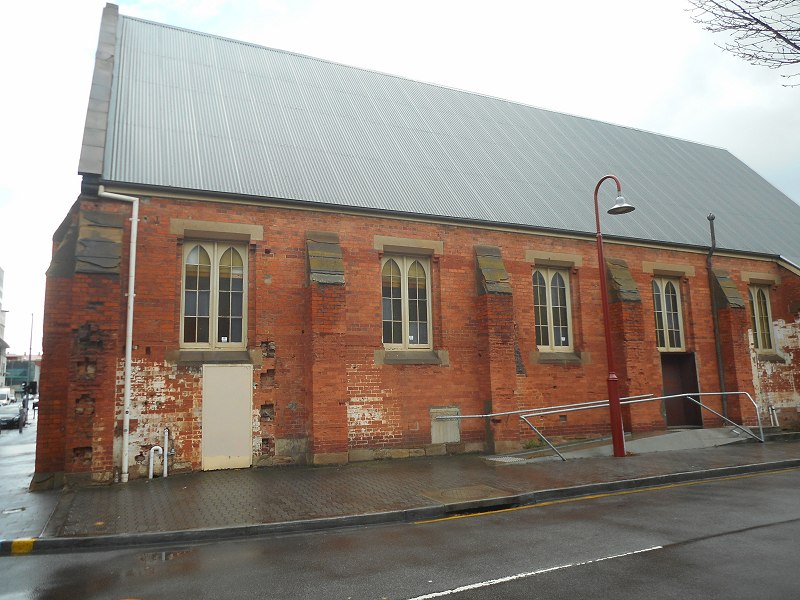7 Campbell St, Hobart. Google Maps.
Built as a mission church associated with St David’s. Opened in 1885.
Became a Mission to Seaman station in 1915, until the 1950s.
OPENING OF ST. DAVID’S MISSION CHURCH.
The pretty little building in Campbell-street, which has been erected as a mission church in connection with St. David’s Cathedral, was opened, and formally dedicated yesterday for religious purposes by Dr. Sandford, Bishop of Tasmania. It is now nearly three years since the movement was set on foot to establish a mission chapel with the object of more effectively reaching the poorer classes of this city, and the late incumbent of St. David’s the Very Rev. Dean Bromby, and his colleague, the Rev. J. C. Mace, entered with their usual zeal and heartiness into the project. Collections were made every month by the Penny Association, in order to raise the nucleus of a fund to defray the cost of the building, and the result was so satisfactory that it was deemed expedient to commence operations. A site was chosen in Lower Campbell-street, the very centre of the well-known Wapping, and the erection of the building, as designed by Mr. H. Hunter, architect, was at once proceeded with. It was estimated that the total cost would amount to £1,500, but owing to some difficulty with the foundation, and the fact that slates had to be used instead of shingles for the roofing, the expense has been considerably more than the original estimate. The foundation stone was laid in November of last year with considerable ceremony by the Bishop of Tasmania, and since that time rapid progress has been made in the erection of the structure.
The chapel, which was so auspiciously opened yesterday, is in the plain Gothic style of architecture, and is built of brick with stone dressing. Above the western elevation is a neat miniature belfry, in which it is intended to place a bell as soon as a suitable one can be obtained. The entrance is from Lower Campbell-street, and passing inside it is found that the interior consists of one long nave 81ft. in length by 32ft in breadth. It was proposed in the first plan to screen off a chancel of about 10ft. in depth, as the chapel is to be used as a school, as well as for religious services, but this part of the scheme was abandoned. Instead of this, the altar, which is well raised, is merely railed off, and the building is thus open from end to end. The altar, which is composed of stained cedar and beautifully proportioned, is the kind gift of Mr. A. J. Lumsden, and has been executed with taste and skill by Mr. Samson, of Hobart. The altar desk is composed of finely polished blackwood, and was the gift of Mr. John Ayton. Among other presents made are the altar linen, tastefully worked and embroidered by Mrs. Holden ; prayer-desk by Mr. Henry Dobson ; Glastonbury chair by the Misses Priest ; brass cross for altar, vases and alms-dish by Mrs. Ware ; and Chalice and Paten by Mrs. W. L. Crowther. Above the altar in the eastern elevation is a “rose” window. It is to be filled in with stained glass by Miss Parsons, Brown’s River, and when completed will have a pretty and effective appearance. The stained glass for the window is being prepared by Messrs. Ferguson and Ure, Sydney, and its arrival is shortly expected. There are six windows along one side of the church, and five on the other, while in the western end there is one on each side of the entrance. They are all filled in with ribbed glass, and the building is thus well-lighted. From the ceiling are suspended three finely ornamented sunlights, which have been fitted up under the superintendence of Mr. Burton. The walls are painted a bluish grey, with a dado of a darker hue, and the seats, which have been supplied by Mr. Smith, are very nicely varnished. About 20 of the seats have reversible backs, and these will be used for school purposes. Every care has been taken to have the building properly ventilated and in this respect the building is as perfect as it possibly could be made. In the south-east corner is a small vestry 14ft. 6in. long by 6ft 6in. broad. The whole of the work has been most carefully and successfully done by the contractors, Messrs. Sharpe, Harrison, and Inches.
The Mercury, 13 July 1885
FIRST MARRIAGE IN ST. DAVID’S MISSION CHURCH.-Yesterday afternoon witnessed the first marriage, ceremony in St. David’s Mission Church. Miss Grace Fookes was wedded to the Rev. J. S. Babington. Great interest was taken in the event by the residents of the mission district, as for several years past Miss Fookes has laboured in their midst as superintendent of the Sunday school and organist at the church services. Tho service was conducted by Rev. S. B. Fookes, father of the bride, assisted by Canon Mason, and at its conclusion Mrs. Babington was presented by the church wardens with a bible–a gift usually made at the initial marriage service in a church. As the bridal party left the building, the feelings of spectators found vent in a shower of flowers. At the close of school last Sun
day afternoon, Miss Fookes was presented by the teachers and scholars with a silver cake basket, as a token of their affection and esteem.
The Mercury, 13 August 1885
MISSION TO SEAMEN.
At the first meeting the Bishop of Tasmania attended of the Diocesan Council he spoke of his desire to do something for the sailors who come to the port of Hobart, and he has continued to interest himself in the matter. Last month, he notified the Council that he had secured a grant from the world-wide “Missions to Seamen Association,” of England — of which our King and Queen are patrons— and which has established itself in most of the chief harbors to which our British sailors go: As, Sydney, Melbourne, and Newcastle there are seamen’s chaplains who devote themselves entirely to the sailor folk, and each of these ports has a seamen’s institute, with its chapel. We understand that our Dean has placed the Campbell-street Mission building at the Bishop’s disposal as a centre for the new venture, and, the missionary in charge will look after the fisherman population in our local “Wapping.” Besides the work on shore, there will be a continuous visitation of all ships coming to Hobart harbor. Mr W. E. Cocks, who has had years of experience of work among sailors in Sydney and New Zealand, has accepted the Bishop’s offer of charge of the mission, and he has already visited Hobart and inspected the scene of his future labors. The Bishop applied to the Diocesan Council for £100 for one year to make up the missionary’s stipend. Unfortunately, all the diocesan funds under the control of the council have been allocated for the current year, and so the ‘Bishop has asked for the individual support of members of the council and other churchmen. It is to he hoped that this first appeal of the Bishop to has diocese on behalf of a new venture by the church will be met by a ready response. — ‘Church News.’
Daily Telegraph, 5 July 1915
MISSION TO SEAMEN
The Missions to Seamen, an English society, which has its branches in every great port of the Empire, has begun
work in Hobart. The missioner is Mr. W Cocks, who has had experience in Wellington, Sydney, and Melbourne ; and the St. David’s Cathedral board has granted the use of a building in Campbell-street. The object of the mission is to save the sailors belonging to or visit the port from the loneliness and the temptations which attend their shore life. The hall provides the opportunity for companionship, refreshments, games, reading, and religious services, and is open to all sailors of every country and creed. A strong committee has been formed with the Bishop of Tasmania as president, to maintain the Mission, and the public is invited to provide for the necessary expenses of management. Subscriptions may be given to any member of the committee, or to the honorary treasurer, Mr. W. Arnold, Rossmoyne, Bathurst-street.
The Mercury, 14 July 1915
OPENING OF THE INSTITUTE.
THE STATE GOVERNOR AND THE BISHOP PRESENT.
The opening of the Hobart Institute for Seamen was performed last evening by his Excellency the Governor (Sir W. EIlison-Macartney) in the presence of a considerable attendance, including Lady EIlison-Macartney, the Bishop of Tasmania (Dr. Stephen), Dean Kite, Sir Elliott Lewis, and Captain Williams and Lieutenant Burton, of the ocean training ship Medway. The institute is situated in Campbell street, opposite the City Hall. After a hymn and prayer, Sir W. EIlison-Macartney declared the institute open, and in doing so paid a brilliant tribute to the work of the seamen’s missions throughout the world. He declared there was no class more deserving of consideration than the members of their mercantile marine. Especially should an island like Tasmania take an interest in the welfare of sailors, since for defence and economic reasons the services rendered by sailors were essential to our existence. Sailors, like the rest of mankind, had their virtues and their failings, but he believed their virtues equalled their failings. He would like to call attention to the part the mercantile marine was playing in the great war struggle. While carrying out their ordinary avocations the sailors had faced dangers of no uncommon character, and faced them in circumstances in which they had no opportunity to retaliate upon the enemy. Men aboard the trawlers in the North Sea and sailors in the Mediterranean, had done much dangerous work. Sailors deserved, then, consideration. They were men who led a roving life away from friends, often serving with different lines and on different ships. (Applause.) Bishop Stephen referred to the good work done by these missions throughout the world. He was struck with the need for such a mission when he arrived in Hobart, and expressed the surprise he felt when a local resident gave voice to the opinion that such an institution was needed. It was needed very badly, and in saying this he would like to pay a tribute to the good work done by tire Sailors’ Home. He appealed for assistance to help to make the mission a success.
Mr. W. E. Cocks, the missionary in charge, read letters from Melbourne and New Zealand, congratulating him on taking up his work in Hobart with Mrs. Cocks. They had been reminded by his Excellency and the Lord Bishop what these missions stood for. Quoting from a report of the work of seamen’s missions, he said the King and Queen were patrons of the movement in the Old Country. Earl Brassey was president, and Mrs. Stewart Knox secretary. This was the 105th port in the Empire at which the mission was established. There were 63 chaplains belonging to the missions, and 144 churches and institutes throughout the world. Over 25,000 services in the year for seamen had been given by the mission. There had been 178,000 letters written in the different institutes in 12 months, He thought the work was a noble one The personal element counted for a good deal, and it was the business of the chaplains and lay workers to get into touch with the sailors. When they visited these sailors on their ships they made themselves at home with them. He made an appeal for pictures for the institute walls. bagatelle table, a gramaphone, as well as large supplies of newspapers and books. Sir Elliott Lewis (in the absence of the State Treasurer), moved a vote of thanks to the Governor for presiding. Dean Kite paid a tribute to the good work done for sailors over a quarter of a century by Mr. and Mrs. Vimpany, of the Sailors’ Rest. Lately Mrs. Vimpany had been called to her rest. She had done wonderful work for sailors visiting Hobart. In acknowledging the vote, his Excellency said he found that he was* vice-admiral for Tasmania, and as such it was his duty to be present at the opening of an institution for seamen. After the singing, of a hymn and the Benediction, pronounced by the Bishop, the proceedings terminated. Many of those in attendance delayed some time to examine the institute, which is being made very attractive for seamen. Formerly it was a Church of England mission church, but the authorities handed it over for the use of the mission. It would also seem that in the person of Mr. Cocks the mission has, as one of the speakers expressed it, the right man for the position.
Critic, 3 September 1915
SEAMEN’S MISSION–A COMPLIMENT.
To the Editor of “The Mercury.”
Sir,-As a recent and frequent visitor to your port, I would like to express my views on your Seamen’s Mission, and the excellent work done by the chaplain, Mr. W. E. Cocks, among shipping, and seamen in general. I always consider that it is a real help to anyone to know that their efforts and endeavours to brighten our lives are appreciated. Hobart as a town should feel proud of having a man of Mr. Cocks’s ability and personality, as without a doubt he is recognised among seamen as one of the finest chaplains they have ever met. During the last 15 or 16 years I, personally, have taken a great interest in missions, and have visited various institutes in nearly every country in the world, black, white, and brindled, and I can safely say that your Hobart mission to seamen is without a doubt one of the best. One is always sure of a genuine, hearty welcome, and can feel certain of spending a very pleasant evening there. One of the best features of this mission is the fine body of men and ladies who so generously lend their support to help towards making the mission a success. This sacrificing an evening a week to assist the chaplain at a time like the present when business men have so many calls on their evenings, is very much to be admired, and in a work of this kind ought to be very much appreciated, as I am sure it is. Some missions one visits in other ports have beautiful up-to-date buildings and requirements, but the complaint one so often hears is “it is so hard to get the men to attend,” the cause generally being that they are not run on the right lines, and not made attractive enough. What suited the sailing ship seamen of a few years ago will not apply to the average colonial seaman, who, broadly speaking, is a far better educated man, and more temperate. Them, nowadays, there are so many other attractions, picture shows, etc., that all help to draw men away. I was particularly struck with the fine attendances, and the homeliness and general aspect of the Hobart Mission, and might add that one often hears in other ports it so well praised, a shining light among missions, and your average seaman is no mild critic, either. I can only repeat that your town ought to feel proud of having such a fine chaplain, and I’ am sure hundreds of others like myself will always wish him and his noble band of helpers every success.
–Yours, etc.,
C.D.H.
S.S. Yarra. Port Augusta,
Spencer Gulf.
The Mercury, 22 July 1916
To the Editor of “The Mercury”
Sir,-I notice, by information in your paper, that an application has been made to the Marine Board for the site of the old Mariners’ Church for a Sailors’ Home and Rest. It this means the starting of another seamen’s institute, may I say it will be a great mistake? Speaking as a sailor, with over 20 years’ experience in all parts of the world, the idea of opposition in this sort of work does not appeal to the sailor. There is already in Campbell-street a mission to seamen, which is doing most excellent work among sailors who visit Hobart. Seaman of all denominations are always given the most hearty welcome there. It has all the requirements the sailor wants, good writing facilities, a splendid library, plenty of reading matter and games of all description, and last, but by no means least, a lot of good and true ladies, who attend there every night, and do their utmost to bring the sailor more in touch with the gentler and better things of life. Trusting this will bring more support to Mr Cocks, the missioner to seamen
Yours etc
HARRY SADLER
The Mercury, 26 April 1918
